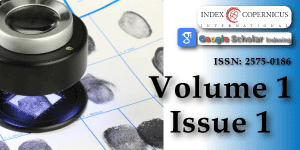Potter Syndrome: A case study
Main Article Content
Abstract
Potter syndrome (PS) is a term used to describe a typical physical appearance, which is the result of dramatically decreased amniotic fluid volume secondary to renal diseases such as bilateral renal agenesis (BRA). Other causes are abstraction of the urinary tract, autosomal recessive polycystic kidney disease (ARPKD), autosomal dominant polycystic kidney disease (ADPKD) and renal hypoplasia. In 1946, Dr Edith Potter characterized this prenatal renal failure/renal agenesis and the resulting physical characteristics of the fetus/infant that result from oligohydramnios as well as the complete absence of amniotic fluid (anhydramnios). Oligohydramnios and anhydramnios can also be due to the result of leakage of amniotic fluid from rupturing of the amniotic membranes. The case reported below, concerns of stillborn boy with potter syndrome.
Article Details
Copyright (c) 2017 Konstantinidou P, et al.

This work is licensed under a Creative Commons Attribution 4.0 International License.
Boucher C, Sandford R. Autosomal dominant polycystic kidney disease (ADPKD, MIM 173900, PKD1 and PKD2 genes, protein products known as polycystin-1 and polycystin-2). Eur J Hum Genet. 2004; 12: 347-354. Ref.: https://goo.gl/bpYdBp
Klaassen I, Neuhaus TJ, Mueller-Wiefel DE, Kemper MJ. Antenatal oligohydramnios of renal origin: long-term outcome. Nephrol Dial Transplant. 2007; 22: 432-439. Ref.: https://goo.gl/5JiLmH
Manoj MG, Kakkar S. Potter’s Syndrome-a fatal constellation of anomalies. Indian J Med Res. 2014; 139: 648-649. Ref.: https://goo.gl/KmdXXU
Eccles MR, Stayner CA. Polycystic kidney disease-where gene dosage counts. F1000Prime Rep. 2014; 6: 24. Ref.: https://goo.gl/5FuqbP
Igarashi P, Somlo S. Genetics and pathogenesis of polycystic kidney disease. J Am Soc Nephrol. 2002; 13: 2384-2398. Ref.: https://goo.gl/55tYuA
Lina F, Satlinb LM. Polycystic kidney disease: the cilium as a common pathway in cystogenesis. Curr Opin Pediatr. 2004; 16: 171-176. Ref.: https://goo.gl/KqGUS6
Adeva M, El-Youssef M, Rossetti S, Kamath PS, Kubly V, et al. Clinical and molecular characterization defines a broadened spectrum of autosomal recessive polycystic kidney disease (ARPKD). Medicine (Baltimore). 2006; 85: 1-21. Ref.: https://goo.gl/TB3fzT
Tahvanainen E, Tahvanainen P, Kääriäinen H, Höckerstedt K. Polycystic liver and kidney diseases. Ann Med. 2005; 37: 546-555. Ref.: https://goo.gl/FnyLH9
Kiernan JA. Histological and Histochemical Methods: Theory and Practice. 4th ed. Bloxham, UK: Scion. 2008.
Sweeney WE Jr, Avner ED. Pathophysiology of childhood polycystic kidney diseases: new insights into disease-specific therapy. Pediatr Res. 2014; 75: 148-157. Ref.: https://goo.gl/1DcSJf
Dias T, Sairam S, Kumarasiri S. Ultrasound diagnosis of fetal renal abnormalities. Best Pract Res Clin Gynaecol. 2014; 28: 403-415. Ref.: https://goo.gl/oEMkNT
Horie S. ADPKD: molecular characterization and quest for treatment. Clin Exp Nephrol. 2005; 9: 282-291. Ref.: https://goo.gl/sfk5hQ

